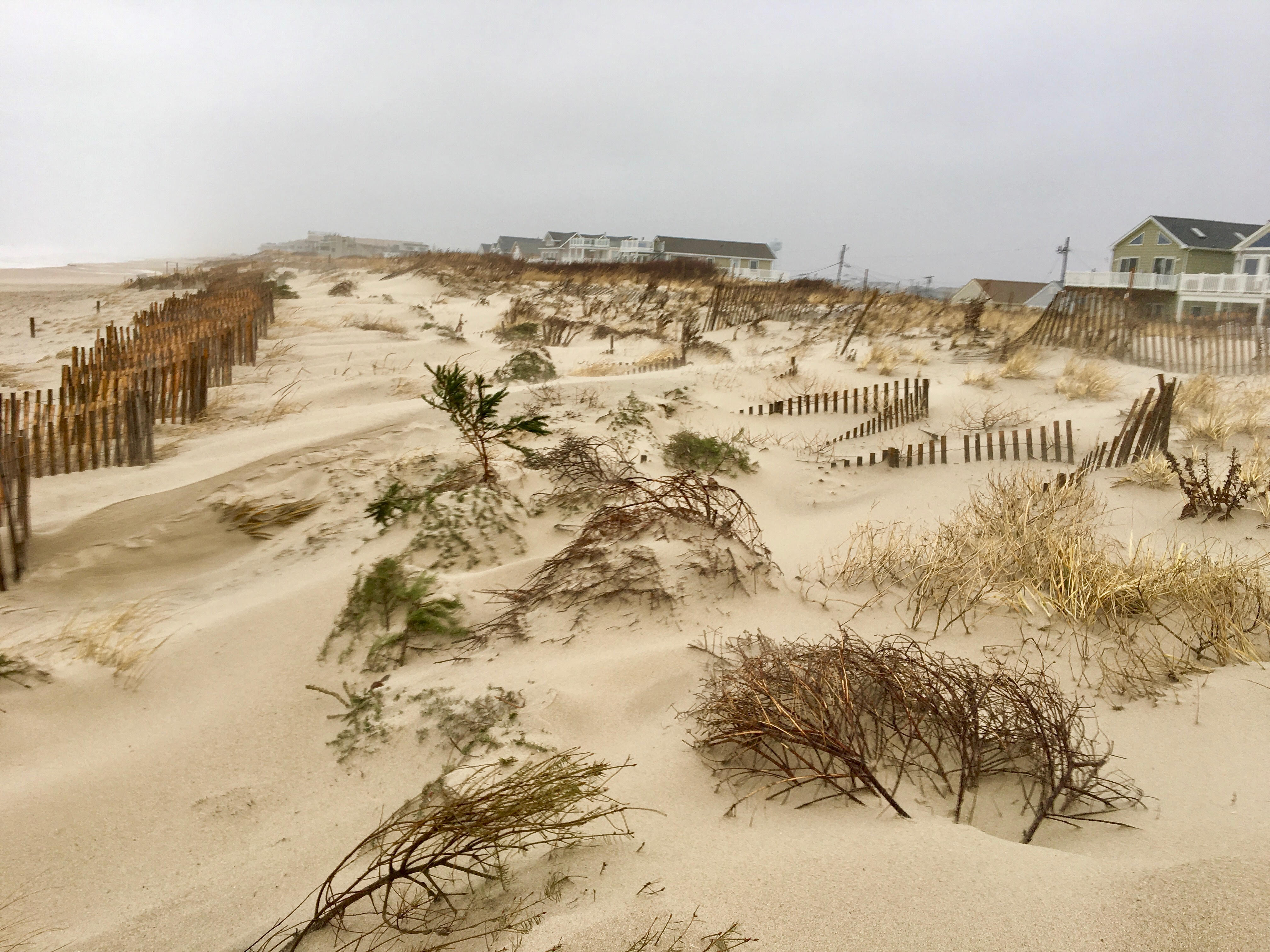Thanks to Christmas trees, dunes in one Ocean County community grew during storm

Newly placed Christmas trees buried in South Seaside Park dunes amid a nor'easter in 2017. (Image courtesy of Dominick Solazzo)
The season of giving is still ongoing in one Ocean County community.
Residents in South Seaside Park’s Midway Beach woke up to larger and higher dunes this morning as a nor’easter continued to impact the Jersey Shore, and strategically placed Christmas trees are a major reason for the growth, said Dominick Solazzo, 44, the resident dune manager.
How it works
Over the course of decades, volunteers in the private community have built up their expansive dune system organically through creative erosion control without any tax dollars.
In recent weeks, Solazzo and volunteers spread donated Christmas trees out throughout the dunes, something that he says is an inexpensive and readily available natural component that helps to supplement Midway Beach’s efforts.
They’re part of a comprehensive dune management system that includes fencing to support growth and dune grass.
According to Solazzo, the Christmas trees trap sand that is blowing toward the dunes with northeasterly winds during coastal storms.
“Wind blown sand becomes obstructed by the fencing and deposited as its velocity slows. The combination of dune fencing and natural vegetation adds the strength of resistance to the dune like rebar to concrete,” Solazzo said in a 2014 NewsWorks interview. “As easily as a healthy and well-managed dune grabs the sand, it also easily resists any erosional pressure put on it by the same force that helps it grow.”
This morning, the Christmas trees are mostly buried, he said.
Solazzo says a special relationship forms over time, resulting in greener and taller dune grass as the trees provide provide nitrogen and other nutrients to feed the grass and also store moisture during the summer months.
But while it works for Midway Beach, he cautions that it’s not the solution for everyone.
“Using Christmas trees to help with dune restoration can be useful but is not the answer in coastal communities where there is a history of moderate to severe coastal erosion,” he said last year. “In Midway, where the houses are set back a few hundred feet away from the ocean, there is plenty of sand to sustain a wide and healthy beach and dune. This provides an ideal location to use Christmas trees to help limit the erosional forces of the wind and collect sand.”
Growing naturally vs. man-made
The protective barrier, grown without any mechanical equipment, spared the community of damage during Superstorm Sandy.
In a 2013 National Geographic article, Stewart Farrell, director of the Stockton University’s Coastal Research Center, said the Midway Beach system represents the “the most dynamic ‘bootstrap’ dune project on the coast.”
“There’s no need for bulldozers or shovels when the wind does the work of building the dune,” he added in the article.
The Coastal Research Center’s 2005 New Jersey Beach Profile Network Annual Report found that the dune at the community’s 6th Lane beach grew gradually over time.
“Initially there was no dune, just a bare sand hill around 6 feet lower than the present crest elevation. The dune width as of November 2004 had reached 130 feet between the landward fence and seaward toe with a maximum crest elevation of 22.3 feet NGVD,” the report said.
Its 2013 report found that the dune “was wide and high enough to be an island of low damage in an otherwise devastated region.”
Two years later, the 2015 report found that sand accumulated at the community’s 6th Lane dune “at the highest rate for any northern Ocean County profile.”
That year, the dune reached around 25 feet high, while the beach was measured at nearly 200 feet wide.
Beach replenishment and dune building slated for the community
Beginning sometime later this year, crews will replenish the community’s beach and build an engineered dune as part of a broader federal project that covers Point Pleasant Beach to South Seaside Park.
According to project details, offshore pumping will supply some 11 million cubic yards of sand along 14-miles of coastline to build dunes 22 feet above sea level and 100 to 300 foot wide beaches 8.5 feet above sea level for most of the project area.
In an email, Bob Considine of the New Jersey Department of Environmental Protection confirmed the community’s inclusion.
When asked about the project’s necessity, he said the project will provide the community with a stronger protective dune system.
“This project will serve not to replace the existing dunes, but to complement and further strengthen them and, of course, tie into the rest of the project and lengthen the beach,” he said.
Considine added that even if they’re around the same height in certain areas of the community, the engineered dunes will be substantially wider than the existing dunes.
“Dunes are not only just a function of height, but the volume of sand and how it will stand up to storm events,” he said, adding that the dunes will be maintained for 50 years after construction.
For Solazzo, it’s all about working with nature
Solazzo says that nature will work with you.
“By repairing our fencing and planting dune grass after Sandy, coastal storms since then have blown sand back into our dunes,” he said in 2014. “The dunes are in some places approaching the same volume or size they were prior to Sandy. With just a little assistance, nature can work for us.”
“Mother Nature is not always against us.”
WHYY is your source for fact-based, in-depth journalism and information. As a nonprofit organization, we rely on financial support from readers like you. Please give today.

